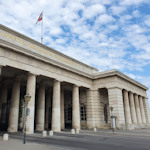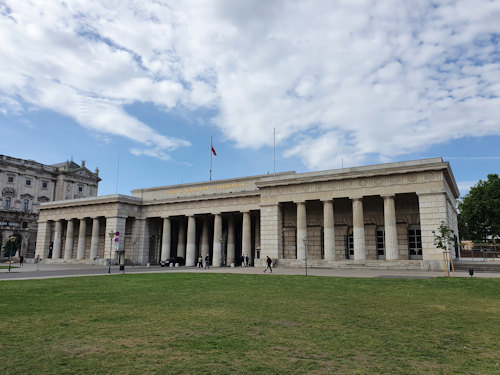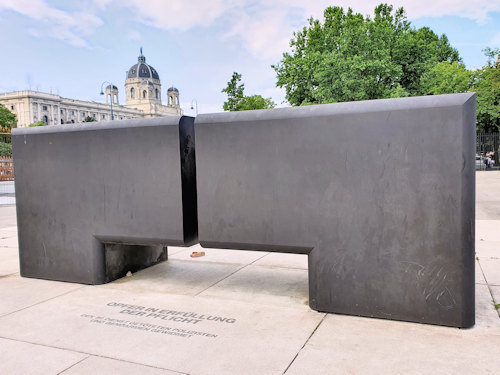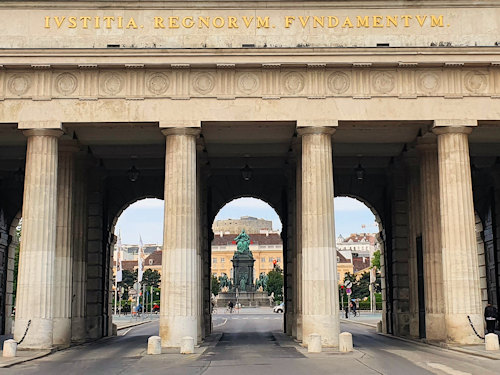
When Emperors build gates, they require more than a bit of wrought iron and a large key. The monumental Burgtor with its triumphal arches serves as a gateway to Vienna’s Hofburg complex but also as a military monument.
- Erected in 1821 in honour of Austrian military success against Napoleon
- Redesigned (internally) across the 1900s to honour the WWI fallen, resistance fighters, and others
- Also known as
- The Äußeres Burgtor (outer Burgtor)
- Heldendenkmal (heroes monument)
- Book a walking tour* of Vienna
- See also:
Gate, monument, place of reflection

(The view from outside)
Burgtor translates directly as castle gate, which leads to entirely the wrong expectations given the lack of moats, bastions or, indeed, any castle at all in the vicinity.
The name does make sense, though, when you consider the nearby area was once an entranceway in the walled fortifications that surrounded Vienna’s old town in earlier centuries.
Blame Napoleon for setting in motion the process that led to the appearance of a free-standing monument: following their 1809 occupation of Vienna, French troops blew up parts of the city fortifications (largely because they could, I think, rather than through any military necessity).

(View of the Burgtor (original concept by Cagnola) with the court stables behind (today’s MuseumsQuartier); painted by Jakob Alt in 1819; Wien Museum Inv.-Nr. 31250; excerpt reproduced under the terms of the CC BY 4.0 license; photo: Wien Museum)
Over the next few years, the Austrians set about various rebuilding efforts, which included constructing what we know as the Burgtor: a gateway within a purely representative curtain wall, leading into Heldenplatz and the Hofburg complex.
The original design by Luigi Cagnola was never completed. Instead, most of what we see can be ascribed to Pietro Nobile (1774-1854). This Swiss-born architect also designed, for example, the nearby Theseus Temple.
The Burgtor’s monumental nature and triumphal arches stem from its second role commemorating the efforts of the Austrian military in dealing with the by-now defeated French.

(Sunset view from outside the square)
This symbolism was brought home by using soldiers as construction workers and setting the official unveiling for October 16th, 1824.
That date was the anniversary of the 1813 Battle of Leipzig, where troops led by Vienna-born Karl Philipp Prince of Schwarzenberg dealt a decisive blow to Napoleon (the prince has his own equestrian statue over on the aptly-named Schwarzenbergplatz square).
Once almost all the city fortifications (new and old) came down in that great period of urban expansion in the late 1800s, the Burgtor remained as a free-standing monument.

(View from Heldenplatz)
Three large inscriptions dominate the long sides (my rough translations):
- Franciscus I. Imperator. Austriae. MDCCCXXIV… Franz I, Emperor of Austria, 1824
- Iustitia. Regnorum. Fundamentum…Justice is the foundation of rule (the motto of Franz I)
- Laurum. Militibus. Lauro. Dignis. MDCCCCXVI…Laurels to soldiers worthy of laurels 1916 (after a WWI fundraising initiative)

(This monument adjacent to the Burgtor honours police officers who lost their life in service.)
While the outside has survived largely intact, the insides of the monument underwent rebuilding and repurposing through the years.
For example, the 1930s saw the Burgtor become a monument to the fallen of WWI (with a veneer of fascism overlying everything given the timeline), with a crypt and open-air halls of honour accessible through gates at the sides.
The 1960s saw the addition of a commemorative room to Austrian resistance fighters, and the whole now serves as more of a general tribute to military sacrifice and effort in pursuit of democratic ideals.

(Provided no cars are on the road and you’re careful, you can get a nice shot of the Maria Theresa monument framed in the arches of the Burgtor.)
As such, you might consider the Burgtor a symbol of Austria escaping its past, difficult though that might be at times.
How to get to the Burgtor
Just follow the travel tips for Heldenplatz square.
Address: Heldenplatz 21/4, 1010 Vienna